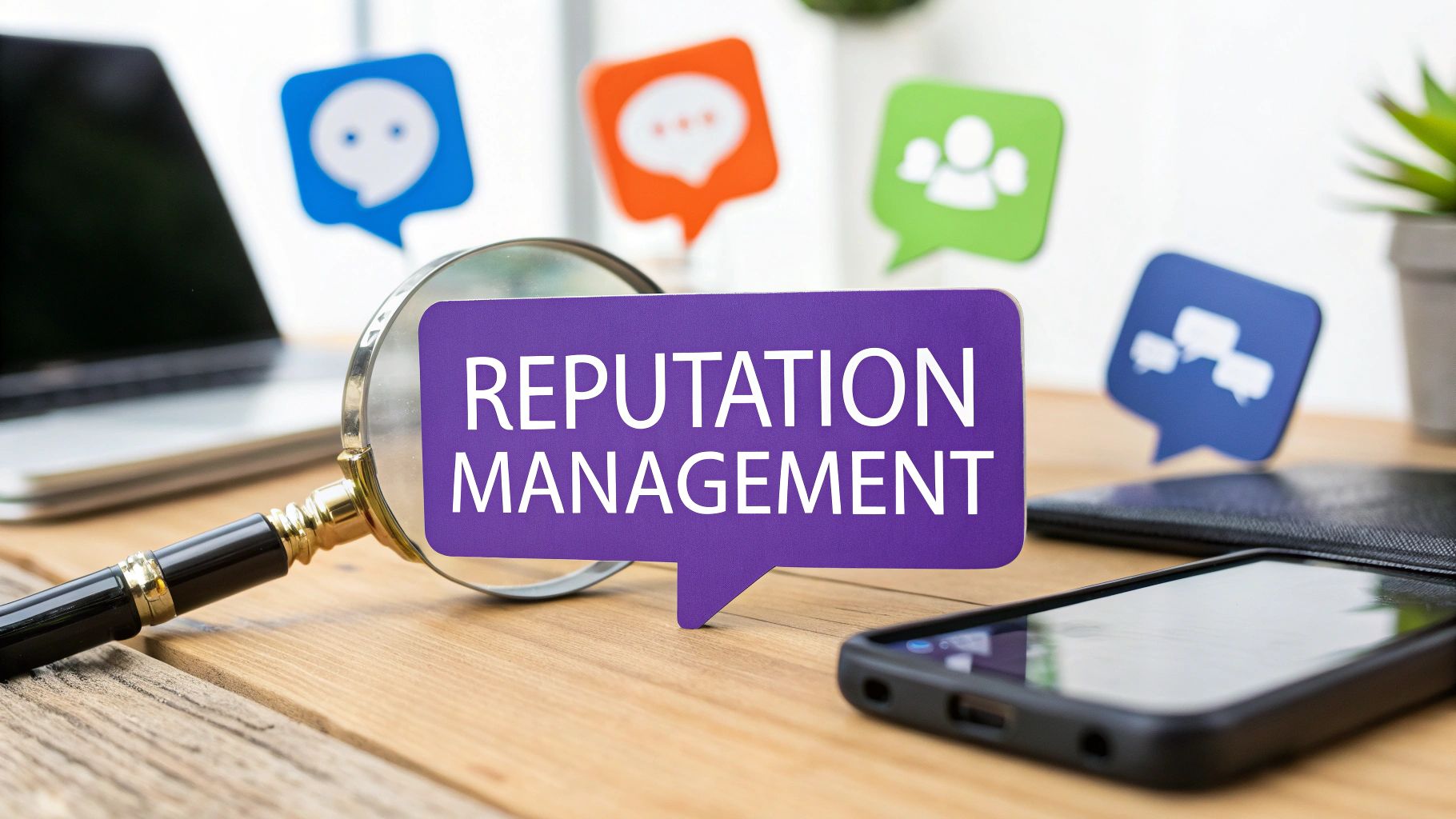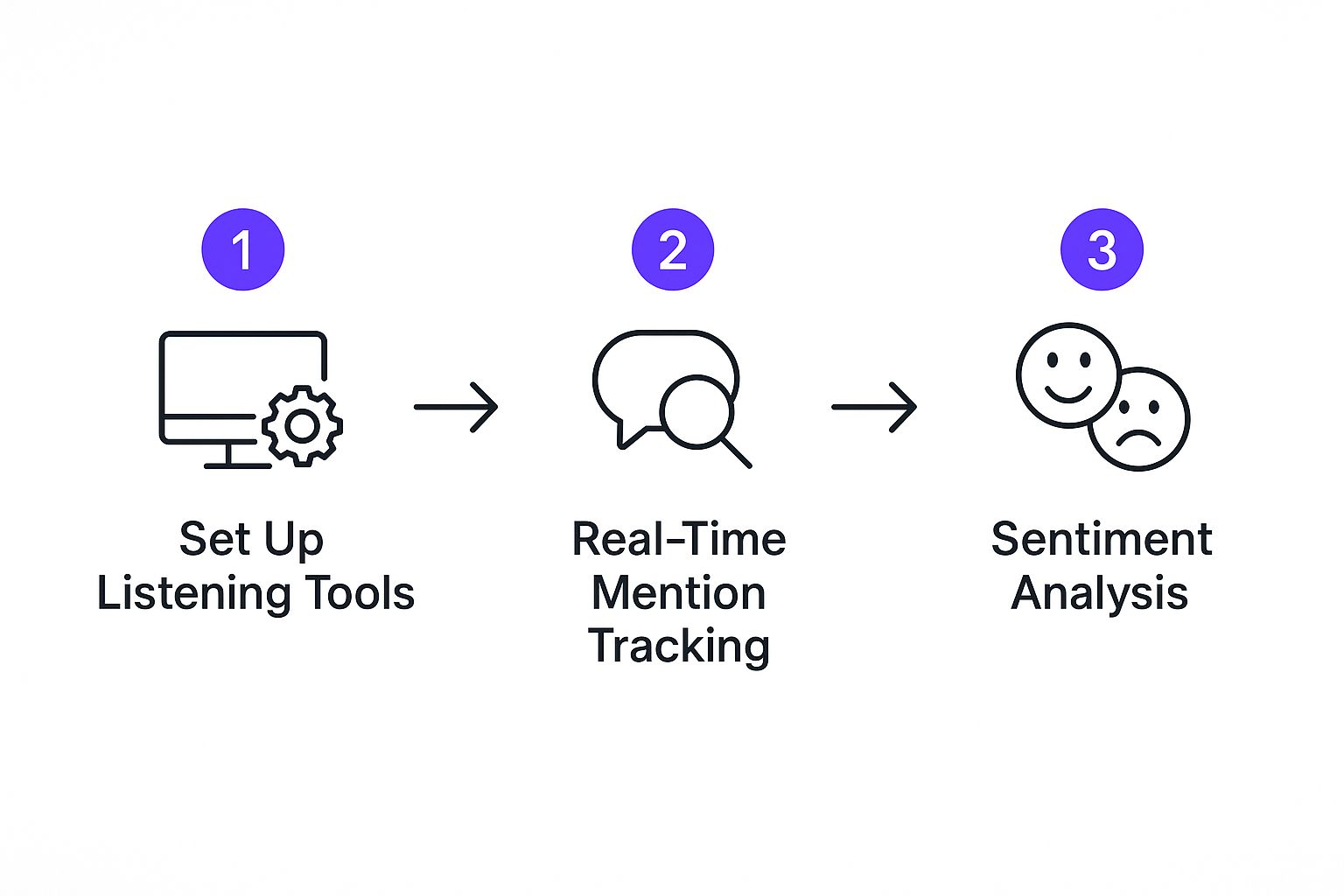Social Media Reputation Management Guide

Think of your brand's social media profiles as your digital front door. For most people, it's the very first impression you'll ever make. Every comment, tag, and review shapes how potential customers see you, and in a world where opinions can change in a flash, you can't afford to be passive.
This is where social media reputation management comes in. It's not just a defensive chore; it's the active, ongoing process of shaping your brand's story online.

This isn’t about chasing a perfect, spotless record. It’s about building a resilient brand identity that can handle scrutiny and build real connections with your audience. At its heart, this practice rests on three core pillars that work together to build a strong, positive presence.
The Three Pillars of Reputation Management
Great reputation management isn't a one-off task but a continuous cycle. Each part fuels the next, creating a solid framework for taking control of your brand’s narrative online.
- Meticulous Monitoring: This is all about keeping your finger on the pulse. It means actively tracking what people are saying about your brand, your products, and even your key people. You have to know what the conversation is before you can join it.
- Constructive Engagement: This is where you step into the conversation. It means interacting with everyone—from your biggest fans to your loudest critics. It shows you’re listening, you care, and you’re committed to your community.
- Proactive Publishing: This is your offense. It involves creating and sharing high-quality content that reinforces what your brand stands for, showcases your expertise, and builds a powerful, positive digital footprint.
Key Insight: The real goal of social media reputation management isn't to be "perfect." It's to be authentic, responsive, and genuinely committed to your customers. That builds far more trust than an unnaturally flawless profile ever could.
Moving Beyond Simple Monitoring
To really get a handle on reputation management, you need to understand the difference between a few key practices. Social monitoring, for example, is about collecting mentions and data—it tells you what people are saying.
Social listening, on the other hand, goes deeper. It’s about analyzing that data to understand the sentiment, context, and trends behind the chatter—the why. If you want to dive deeper, this Social Listening vs Monitoring: A Complete Guide is a fantastic resource that breaks it all down.
This deeper level of understanding is what allows you to shift from being reactive to proactive. Instead of just putting out fires, you can start to see shifts in customer sentiment and get ahead of potential issues before they blow up. By weaving these practices together, you turn social media from a simple marketing channel into a powerful business intelligence tool. It’s a strategic move that builds trust, loyalty, and ultimately protects your bottom line.
Why Online Reputation Now Drives Business Success

In the not-so-distant past, a company's reputation was built one conversation at a time, through word-of-mouth chatter in local communities. Today, those conversations have moved online, exploding onto a global stage across platforms like Facebook, X, and Instagram.
Your online reputation isn't just a passive metric anymore. It's an active, powerful engine that directly fuels customer growth and keeps your business thriving.
Think of it like this: every review, comment, and tagged photo is a digital breadcrumb. These breadcrumbs lead potential customers either straight to your door or down a path to your competitors. A steady stream of positive feedback creates a clear trail of trust. On the other hand, negative comments create a digital dead end.
This fundamental shift means social media reputation management is no longer about just putting out fires—it's about strategic, intentional growth.
The sheer power of this digital word-of-mouth is undeniable. A jaw-dropping 85% of consumers now trust online reviews just as much as a recommendation from a friend. That single statistic reveals how dramatically the landscape of influence has changed.
The New Currency of Trust
When someone is thinking about making a purchase, their first stop usually isn't your website. It's the social media pages and review sites where real customers share their raw, unfiltered experiences. This user-generated content has become the new currency of trust.
This feedback loop has a direct, measurable impact on your bottom line.
A single negative review can scare away up to 30 potential customers. On the flip side, businesses that actively manage their feedback and cultivate a positive presence see a clear and powerful return on that investment in trust.
The table below breaks down just how much online reviews influence customer behavior and, ultimately, a business's success.
The Impact of Online Reviews on Consumer Behavior
| Statistic | Impact on Business |
|---|---|
| 85% of consumers trust online reviews as much as personal recommendations. | A positive online reputation directly builds trust and credibility with potential buyers. |
| A one-star increase in Yelp rating leads to a 5-9% increase in revenue. | Small improvements in ratings can have a significant financial impact. |
| 92% of consumers are less likely to use a business after reading negative reviews. | Negative feedback is a major deterrent that can turn away a vast majority of prospects. |
| 72% of customers won't take action until they've read reviews. | Reviews are a critical part of the modern customer journey; without them, you're invisible. |
These numbers tell a clear story: managing your online reputation isn't optional. It’s a core business function with real financial consequences. In this high-stakes environment, every star in a rating truly matters.
From Perception to Profit
The line between online perception and real-world profit has never been clearer. A strong reputation acts like a magnet for new customers, lowering your acquisition costs and increasing the lifetime value of your audience. When people see others praising your brand online, it validates their decision to choose you.
Here’s how a positive online presence translates into tangible business results:
- Increased Customer Trust: Positive reviews and quick, helpful responses show that your brand is reliable and genuinely cares.
- Higher Conversion Rates: Social proof from happy customers removes friction from the buying process, giving new buyers the confidence to click "purchase."
- Improved Brand Loyalty: When customers feel heard and valued online, they’re far more likely to come back for more and become vocal advocates for your brand.
Ultimately, effective social media reputation management transforms your online presence from a simple communication channel into one of your most valuable assets. It builds a protective layer of credibility around your brand, helping you not only survive but thrive.
Of course, managing reputation also means protecting user data. You can read about our commitment to that in our MakerBox privacy policy.
Your Playbook for Proactive Reputation Management
Great social media reputation management isn't about sitting around, waiting for a crisis to hit. It's about getting ahead of the conversation with a smart, consistent strategy. Think of it as building a strong reputational immune system for your brand.
This playbook breaks it down into three core pillars: Proactive Monitoring, Strategic Engagement, and Narrative Control. Mastering these areas shifts you from playing defense to playing offense, letting you actively shape how your brand is seen online. This isn't just damage control; it's brand building from the ground up.
Proactive Monitoring: The Foundation of Awareness
You can't manage what you don't see. Proactive monitoring is the bedrock of any solid reputation strategy. It’s all about creating a system that acts as your brand’s digital eyes and ears, catching every important conversation, mention, and review the moment it happens.
This is more than just checking your notifications. Real monitoring means using social listening tools to track keywords tied to your brand, products, industry, and even your key people. The goal is to get a full, unbiased picture of public sentiment before it hardens into a widespread opinion.
Here’s a look at the basic steps for setting up a proactive monitoring system.

This simple, three-step flow ensures you’re not just gathering data but are ready to analyze and act on it. By setting up listening tools, tracking mentions, and analyzing sentiment, you gain the clarity needed to respond effectively and on time.
Strategic Engagement: Turning Feedback into an Asset
Once you know what people are saying, it's time to engage. Every comment, good or bad, is a chance to show what your brand is made of. How you respond says everything about your company’s character and commitment to its customers. A thoughtful engagement strategy can turn critics into fans and fans into evangelists.
Responding isn't just polite; it's smart business. Research shows that when customers feel heard, 70% of them will do business with that company again, even after a bad experience. Even better, businesses that reply to at least a quarter of their reviews earn, on average, 35% more revenue. The financial upside is real.
Key Takeaway: Never underestimate the power of a timely, empathetic response. The goal isn't to win an argument but to show you're listening and that you care. This simple act builds immense trust.
A solid framework for engagement includes:
- Responding to Negativity Promptly: Address negative comments quickly and publicly. Acknowledge the issue, show empathy, and offer to take the conversation to a private channel like DM or email to resolve it. This signals transparency and a real desire to find a solution.
- Amplifying Positivity: When you get positive feedback, don't just "like" it—share it! Feature user-generated content, thank customers for their kind words, and engage with their posts. This encourages more positive interactions and creates powerful social proof.
- Knowing When to Step Back: Not every comment deserves a response. Don’t get pulled into arguments with obvious trolls or people just trying to start a fire. Save your energy for genuine customer feedback.
Narrative Control: Shaping Your Brand Story
The final pillar is all about narrative control. While monitoring and engagement are about reacting and interacting, this part is purely proactive. It involves creating and sharing valuable content that tells your brand's story on your terms. A strong content strategy acts as a "reputational shield," building up a reserve of positive assets that can insulate you from the occasional negative comment.
This is where you show off your expertise, pull back the curtain on your company culture, and share customer success stories. By consistently publishing content that reinforces your values, you get to define what your brand stands for in the public's mind.
Consider these content types for taking control of your narrative:
- Thought Leadership Articles: Prove you know your stuff by providing real value and insight to your audience.
- Behind-the-Scenes Content: Humanize your brand by showing the people and processes that make your company tick.
- Customer Spotlights and Testimonials: Let your happy customers do the talking. Their words carry more weight than any marketing copy you could write.
- Community-Building Initiatives: Highlight your company's positive impact, whether it's through charitable work or community involvement.
When you create a steady stream of positive, authentic content, you make it much harder for a few negative comments to define your brand. You are actively building the reputation you want, one post at a time. Of course, all actions must comply with platform rules, a principle detailed in our MakerBox terms of service.
Of course. Here is the rewritten section, formatted to sound completely human-written and natural, following the provided style guide and examples.
How to Navigate a Social Media Crisis

Sooner or later, every brand hits a patch of turbulence. It’s almost a rite of passage. A negative story catches fire, a new product flops spectacularly, or an employee has a very public, very bad day. In those moments, having a game plan is what separates a controlled landing from a full-on tailspin.
A social media crisis isn't just a handful of angry comments. It’s a high-stakes event that can threaten your brand's integrity and spiral out of control in minutes. The secret is to act fast and with purpose, following a clear framework that turns a scary challenge into a series of manageable steps.
Honestly, how you behave in the first few hours is everything. If you respond with speed, transparency, and a real sense of ownership, you can do more than just minimize the damage. You might even come out stronger by showing your customers what your brand is really made of when the pressure is on.
The Initial Response Framework
When that fire ignites, your first moves are the most important ones. Don’t freeze. This is where all that proactive social media reputation management work pays off, allowing you to act with confidence instead of fear.
Think of your immediate response in three simple stages:
- Detect and Assess: Your social listening tools are your early warning system. The moment you see a huge spike in negative chatter or a critical issue pops up, you need to figure out how bad it is. Is this a contained problem with a few customers, or is it a wildfire about to go viral?
- Activate Your Team: Get your crisis team on a call—now. This should be a pre-selected group from marketing, PR, legal, and support who have the authority to make decisions without wading through corporate red tape.
- Halt Scheduled Posts: Immediately pause all your scheduled social media content. Nothing kills a sincere apology faster than a cheerful, pre-planned "Happy Friday!" post popping up in the middle of a meltdown.
This initial phase is all about getting control of the situation on your end before you ever say a word to the public.
Communicating with Transparency and Ownership
Once you’ve got your bearings, it’s time to communicate. And how you talk about the problem is just as critical as how you fix it. Today’s customers can spot corporate jargon and evasive double-talk from a mile away.
Key Principle: Take responsibility, don't make excuses. Acknowledge the issue and the customer's frustration directly. Even if the problem wasn't entirely your fault, owning your part of the resolution builds immediate credibility.
Your public communication should be methodical. Start with a quick holding statement. Something simple that says you're aware of the issue and looking into it. This shows you're on it and buys you a little time to get the facts straight. Then, follow up with a more detailed explanation and, crucially, a clear plan for what you’re doing to make things right.
Anonymized Case Study: A Service Outage
Picture this: a popular SaaS company has a massive, unexpected outage. Within minutes, users on X (formerly Twitter) are reporting they can’t log in, and the frustration is building fast.
- Wrong Response (Denial and Delay): The company goes completely silent for hours. They start deleting negative comments while scrambling to fix the issue behind the scenes. This radio silence just fuels speculation and anger, turning a technical glitch into a massive crisis of trust.
- Right Response (Ownership and Clarity): Within 15 minutes, the company posts across all its social channels: "We are aware of a major service outage affecting our users. Our entire engineering team is working to resolve this as our top priority. We will provide another update in 30 minutes." They stick to that promise, giving regular, honest updates until the service is back. Afterward, they issue a formal apology, explain what went wrong, and detail the steps they’re taking to prevent it from happening again.
This proactive approach shows you respect your customers and their time. It reinforces that your brand is reliable, even when things go wrong. For a deeper look into preparing for these situations, it's worth exploring comprehensive social media crisis management strategies to build out your own playbook.
The Best Tools for Modern Reputation Management
Let's be honest: you can't manage a modern online reputation by just scrolling through your feeds anymore. The sheer volume of conversation is overwhelming. Today, effective social media reputation management relies on smart technology that can track, analyze, and make sense of millions of online conversations in real time. These tools don't just find mentions; they give you the strategic intel you need to act with confidence.
To make sense of it all, we can break these tools down into three main categories. Each plays a distinct role, but they work together like specialized instruments in an orchestra, creating a harmonious brand presence online.
Social Listening Platforms
First up are social listening platforms. Think of these as your digital radar, constantly scanning the web for conversations about your brand, competitors, and industry. They’re your early warning system, designed to catch emerging trends and potential crises before they blow up. To really get ahead, you need solid social listening strategies to make sense of what people are really feeling.
These tools are great at:
- Real-Time Monitoring: Keeping an eye on mentions across social media, blogs, forums, and news sites as they happen.
- Sentiment Analysis: Automatically telling you if a mention is positive, negative, or neutral, so you get a quick read on public opinion.
- Competitor Benchmarking: Watching what’s being said about your rivals, which helps you spot their weaknesses and your opportunities.
Platforms like Brandwatch or Mention are heavy hitters in this space, giving you the powerful analytics needed to understand the "why" behind the "what" of online chatter.
Review Management Software
Next, we have review management software. These tools are your direct line to customer feedback on crucial sites like Google, Yelp, and other industry-specific review platforms. Since a huge chunk of consumers rely on reviews before buying anything, you absolutely cannot ignore them.
These platforms bring all that feedback into one place, letting you:
- Aggregate Reviews: Pull all your reviews from different sites into a single, clean dashboard.
- Streamline Responses: Reply to reviews directly from the platform, so no customer comment gets left behind.
- Generate New Reviews: Run automated campaigns to nudge happy customers into sharing their positive experiences.
Solutions like Trustpilot or GatherUp are built for this, helping businesses transform customer feedback from a chore into a powerful marketing tool.
AI-Powered Reputation Suites
The biggest leap forward in this field is the emergence of AI-powered suites. These are the all-in-one platforms that combine social listening, review management, and even predictive analytics into a single, intelligent system. They're moving the game from simply reacting to what's happened to proactively shaping what happens next.
This shift toward AI and machine learning is one of the defining trends of 2025. Artificial intelligence—made popular by tools like ChatGPT and DALL-E—is now a core business tool. It allows brands to sift through massive amounts of data from reviews, social media, and news sources with incredible speed and accuracy. These AI tools don't just spot problems; they can recommend steps to take before a small issue becomes a full-blown crisis.
The AI Advantage: AI doesn't just collect data; it connects the dots. An AI suite can spot a growing wave of negative sentiment on X (formerly Twitter), trace it back to a batch of bad reviews on Google, and flag it for your team—all before it escalates.
Platforms like MakerBox integrate these capabilities, using AI to not only see what's being said but also to help you create the right content to steer the conversation. By analyzing what makes other profiles and posts successful, it helps you build a strong, positive online presence that acts as a natural defense against negativity. This makes sophisticated reputation management something anyone can achieve.
Building a Brand Reputation That Lasts
Let's be real: effective social media reputation management isn't just about playing defense. It's about building a brand so solid and authentic that it can handle whatever comes its way. The best in the business aren't just reacting to comments; they’re proactively creating an unshakeable, positive presence that stands the test of time. Think of it as building a reputational shield, one genuine interaction at a time.
This long-term mindset shifts reputation management from a series of frantic, one-off fixes to a steady, ongoing commitment. When you consistently show up, deliver value, and engage like a real human, you build a brand that doesn't just survive challenges—it thrives because of the deep trust it has earned from its community.
Turn Happy Customers into Your Biggest Fans
Your most powerful asset isn't your marketing budget; it's your happy customers. When you cultivate a loyal community of brand advocates, you create an organic defense system. These are the people who will jump into a conversation to defend you, share positive stories, and recommend you without you ever having to ask.
Here's how you can actively nurture this community:
- Encourage Positive Reviews: Don't be shy. A simple, polite email or even a QR code in your packaging can make a huge difference. With 76% of all reviews landing on either Google or Facebook, you know where to focus your energy.
- Showcase User-Generated Content (UGC): Someone tagged you in an awesome photo? Ask for their permission to feature it. Sharing UGC is a powerful form of social proof because it's real and relatable—far more credible than a slick, polished ad.
- Engage in a Meaningful Way: Go beyond just "liking" comments. Ask questions, start conversations, and show you're genuinely interested in what your followers have to say.
Key Takeaway: Brand advocates are your most valuable allies. Treat them like the VIPs they are, because their authentic voice and unwavering support are the bedrock of a resilient reputation.
The Power of Authentic Storytelling
At the end of the day, your long-term reputation is built on the story you tell. Authentic brand storytelling is your chance to connect with people on a human level, moving the conversation beyond just products and services. Share your company's mission, celebrate your team's wins, and be transparent about what you stand for.
Meaningful corporate initiatives can also have a massive impact on how people see you. Whether it’s supporting a local charity, launching a sustainability program, or getting behind a cause your community is passionate about, these actions show your brand is about more than just the bottom line.
This proactive approach builds a deep reservoir of goodwill. So, when a negative issue inevitably pops up, it’s seen as an outlier—an exception to an otherwise stellar track record, not the thing that defines your brand. A strong, lasting reputation is really built on a simple promise: delivering consistent value and treating people with respect, day in and day out.
Have Questions? We Have Answers.
Let's be honest: the world of social media reputation management can feel a little overwhelming at first. It's natural to have questions as you shift from understanding the theory to putting it into practice. Here are some straightforward answers to the most common questions we hear.
How Often Should I Be Monitoring My Brand?
For most businesses, daily monitoring is the absolute minimum. You should be checking your key social platforms at least once a day for new mentions, comments, and DMs. This simple habit is often enough to catch small issues before they snowball.
However, if you're a larger brand, in the middle of a product launch, or navigating a sensitive issue, you need to step it up to real-time monitoring. A negative story can catch fire and spread across social media in a matter of hours. In those moments, constant vigilance with specialized tools isn't just a good idea—it's your best defense.
Should I Respond to Every Single Comment?
Not necessarily. The key here is to be strategic, not exhaustive. You don't need to reply to every last comment, but you do need a clear plan for prioritizing.
- Negative Feedback & Questions: These are non-negotiable. Always respond. A quick, public acknowledgment that offers a path to a solution shows you’re transparent and builds trust. You can always move the conversation to a private channel afterward.
- Positive Feedback: Definitely engage with a good chunk of these. A thoughtful reply helps build a real community. That said, sometimes a simple "like" is all it takes to show you're listening. Don't feel pressured to write a custom novel for every "Great product!" comment.
Key Insight: The goal isn't to reply to everyone but to make everyone who needs a reply feel heard. Focus your energy where it makes the biggest impact—solving problems and building genuine relationships.
What's the Difference Between Social Monitoring and Social Listening?
This is a common point of confusion, but the distinction is actually quite simple. Think of it this way: monitoring is about collecting the dots, while listening is about connecting them to see the bigger picture.
Social monitoring is the act of gathering data. It’s the process that scoops up every mention, hashtag, and comment related to your brand. It answers the basic question, "What are people saying?"
Social listening, on the other hand, is the analysis of all that data. It’s where you step back to understand sentiment, spot trends, and uncover strategic insights. It answers the far more crucial question, "Why are they saying it, and what should we do about it?" Monitoring is the tactic; listening is the strategy.
Is It Ever Okay to Delete Negative Comments?
Almost never. The only time you should even consider deleting a comment is if it clearly violates your community guidelines—think hate speech, spam, or personal attacks.
Deleting valid criticism usually just pours gasoline on the fire. It makes your brand look shady, like you have something to hide. A customer who sees their legitimate complaint get deleted is likely to get even angrier and louder. A transparent public response is a much, much better approach for effective social media reputation management.
Ready to take control of your online story? MakerBox uses powerful AI to help you build an impressive, professional social media presence in seconds. Stop guessing and start growing—transform your profiles, create engaging content, and build the reputation you deserve. Elevate your online presence with MakerBox today.





